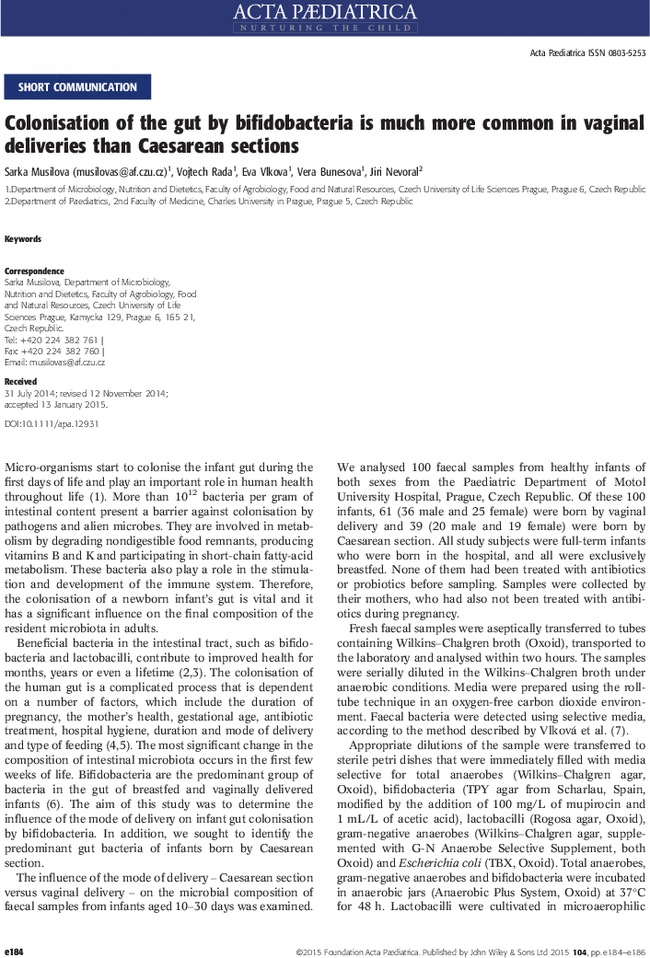Colonisation of the gut by bifidobacteria is much more common in vaginal deliveries than Caesarean sections
Corresponding Author
Sarka Musilova
Department of Microbiology, Nutrition and Dietetics, Faculty of Agrobiology, Food and Natural Resources, Czech University of Life Sciences Prague, Prague 6, Czech Republic
Correspondence
Sarka Musilova, Department of Microbiology, Nutrition and Dietetics, Faculty of Agrobiology, Food and Natural Resources, Czech University of Life Sciences Prague, Kamycka 129, Prague 6, 165 21, Czech Republic.
Tel: +420 224 382 761 |
Fax: +420 224 382 760 |
Email: [email protected]
Search for more papers by this authorVojtech Rada
Department of Microbiology, Nutrition and Dietetics, Faculty of Agrobiology, Food and Natural Resources, Czech University of Life Sciences Prague, Prague 6, Czech Republic
Search for more papers by this authorEva Vlkova
Department of Microbiology, Nutrition and Dietetics, Faculty of Agrobiology, Food and Natural Resources, Czech University of Life Sciences Prague, Prague 6, Czech Republic
Search for more papers by this authorVera Bunesova
Department of Microbiology, Nutrition and Dietetics, Faculty of Agrobiology, Food and Natural Resources, Czech University of Life Sciences Prague, Prague 6, Czech Republic
Search for more papers by this authorJiri Nevoral
Department of Paediatrics, 2nd Faculty of Medicine, Charles University in Prague, Prague 5, Czech Republic
Search for more papers by this authorCorresponding Author
Sarka Musilova
Department of Microbiology, Nutrition and Dietetics, Faculty of Agrobiology, Food and Natural Resources, Czech University of Life Sciences Prague, Prague 6, Czech Republic
Correspondence
Sarka Musilova, Department of Microbiology, Nutrition and Dietetics, Faculty of Agrobiology, Food and Natural Resources, Czech University of Life Sciences Prague, Kamycka 129, Prague 6, 165 21, Czech Republic.
Tel: +420 224 382 761 |
Fax: +420 224 382 760 |
Email: [email protected]
Search for more papers by this authorVojtech Rada
Department of Microbiology, Nutrition and Dietetics, Faculty of Agrobiology, Food and Natural Resources, Czech University of Life Sciences Prague, Prague 6, Czech Republic
Search for more papers by this authorEva Vlkova
Department of Microbiology, Nutrition and Dietetics, Faculty of Agrobiology, Food and Natural Resources, Czech University of Life Sciences Prague, Prague 6, Czech Republic
Search for more papers by this authorVera Bunesova
Department of Microbiology, Nutrition and Dietetics, Faculty of Agrobiology, Food and Natural Resources, Czech University of Life Sciences Prague, Prague 6, Czech Republic
Search for more papers by this authorJiri Nevoral
Department of Paediatrics, 2nd Faculty of Medicine, Charles University in Prague, Prague 5, Czech Republic
Search for more papers by this author
References
- 1Mshvildadze M, Neu J, Shuster J, Theriaque D, Li N, Mai V. Intestinal microbial ecology in premature infants assessed with non-culture-based techniques. J Pediatr 2010; 156: 20–5.
- 2Salminen S, Gibson GR, McCartney AL, Isolauri E. Influence of mode of delivery on gut microbiota composition in seven year old children. Gut 2004; 53: 1388–9.
- 3Grönlund MM, Lehtonen OP, Eerola E, Kero P. Fecal microflora in healthy infants born by different methods of delivery: permanent changes in intestinal flora after cesarean delivery. J Pediatr Gastroenterol Nutr 1999; 28: 19–25.
- 4Orrhage K, Nord CE. Factors controlling the bacterial colonization of the intestine in breastfed infants. Acta Paediatr 1999; 88: 47–57.
- 5Neu J, Rushing J. Cesarean versus vaginal delivery: long-term infant outcomes and the hygiene hypothesis. Clin Perinatol 2011; 38: 321–31.
- 6Fallani M, Young D, Scott J, Norin E, Amarri S, Adam R, et al. Intestinal microbiota of 6-week-old infants across Europe: geographic influence beyond delivery mode, breast-feeding, and antibiotics. J Pediatr Gastroenterol Nutr 2010; 51: 77–84.
- 7Vlková E, Nevoral J, Jencikova B, Kopečný J, Godefrooij J, Trojanová I, et al. Detection of infant faecal bifidobacteria by enzymatic methods. J Microbiol Methods 2005; 60: 365–73.
- 8Biasucci G, Rubini M, Riboni S, Morelli L, Bessi E, Retetangos C. Mode of delivery affects the bacterial community in the newborn gut. Early Human Dev 2010; 86: 13–5.
- 9Penders J, Thijs C, Vink C, Stelma FF, Snijders B, Kummeling I, et al. Factors influencing the composition of the intestinal microbiota in early infancy. Pediatrics 2006; 118: 511–21.
- 10Van Nimwegen FA, Penders J, Stobberingh EE, Postma DS, Koppelman GH, Kerkhof M, et al. Mode and place of delivery, gastrointestinal microbiota, and their influence on asthma and atopy. J Allergy Clin Immunol 2011; 128: 948–55.
- 11Di Gioia D, Aloisio I, Mazzola G, Biavati B. Bifidobacteria: their impact on gut microbiota composition and their applications as probiotics in infants. Appl Microbiol Biotechnol 2014; 98: 563–77.
- 12Braga TD, da Silva GA, de Lira PI, de Carvalho Lima M. Efficacy of Bifidobacterium breve and Lactobacillus casei oral supplementation on necrotizing enterocolitis in very-low-birth-weight preterm infants: a double-blind, randomized, controlled trial. Am J Clin Nutr 2011; 93: 81–6.
- 13Underwood MA, Kananurak A, Coursodon CF, Adkins-Reick CK, Chu H, Bennett SH, et al. Bifidobacterium bifidum in a rat model of necrotizing enterocolitis: antimicrobialpeptide and protein responses. Pediatr Res 2012; 71: 546–51.
- 14Mikami K, Takahashi H, Kimura M, Isozaki M, Izuchi K, Shibata R, et al. Influence of maternal bifidobacteria on the establishment of bifidobacteria colonizing the gut in infants. Pediatr Res 2009; 65: 669–74.
- 15Indrio F, Di Mauro A, Riezzo G, Francavilla R. Microbiota in healthy term infant. Early Hum Dev 2013; 8954: 15–7.




